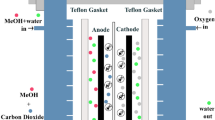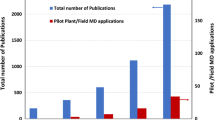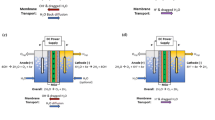Abstract
The effect of incorporation of alumina nanoparticles on the gas separation properties of the polysulfone–polyethylene glycol blend membranes containing 20% polyethylene glycol was examined. At first, a number of nanocomposite polysulfone–polyethylene glycol/alumina membranes were synthesized with alumina nanoparticles loaded into the polymer matrixes. The hybrid membranes were synthesized with six different alumina contents of 2.5, 5, 10, 15, 20, and 30 wt%. The polysulfone–polyethylene glycol and their hybrids inclusive alumina membranes were prepared via thermal phase-inversion method. The membranes were initially characterized using Fourier transform infrared spectroscopy, scanning electron microscope, and X-ray diffraction. Gas permeation properties of these membranes with different alumina contents were investigated for pure CO2, CH4, N2, and O2 gases. The results showed that not only these gases permeability but the CO2/N2, CO2/CH4, and O2/N2 ideal selectivity were improved with increasing alumina nanoparticle content of the membrane as well. Also the effect of feed pressure on the permeation properties of these membranes was investigated for pure CO2 gas. Finally, the results from the synthesized membranes were compared with Robeson’s upper bound line.







Similar content being viewed by others
References
Abu-Zahra MRM, Feron PHM, Jansens PJ et al (2009) New process concepts for CO2 post-combustion capture process integrated with coproduction of hydrogen. J Hydrog Energy 34:3392–4004
Adhikari AK, Lin KS (2016) Improving CO2 adsorption capacities and CO2/N2 separation efficiencies of MOF-74(Ni, Co) by doping palladium-containing activated carbon. J Chem Eng 284:1348–1360
Ameri E, Sadeghi M, Zarei N et al (2015) Enhancement of the gas separation properties of polyurethane membranes by alumina nanoparticles. J Membr Sci 479:11–19
Baker RW (2000) Membrane technology and applications, 1st edn. McGraw-Hill, New York
Barquín AF, Coterillo CC, Palomino M et al (2016) Permselectivity improvement in membranes for CO2/N2 separation. Sep Purif Technol 157:102–111
Berchtold KA (2006) Novel polymeric-metallic composite membranes for CO2 separation at elevated temperatures. In: American filtration and separation society fall topical conference, Pittsburgh
Brunettia A, Scuraa F, Barbieria G et al (2010) Membrane technologies for CO2 separation. J Membr Sci 359:115–125
Carreon MA, Li S, Falconer JL et al (2008) Alumina-supported SAPO-34 membranes for CO2/CH4 separation. J Am Chem Soc 130:5412–5413
Cavenati S, Grande CA, Rodrigues AE (2006) Removal of carbon dioxide from natural gas by vacuum pressure swing adsorption. Energy Fuels 20:2648–2659
Fernandez E, Medrano JA, Melendez J et al (2016) Preparation and characterization of metallic supported thin Pd–Ag membranes for hydrogen separation. J Chem Eng 305:182–190
Kargari A, Takht Ravanchi M (2012) Carbon dioxide: capturing and utilization. Intech Croatia 1:3–30
Khosravi A, Sadeghi M, Zare Banadkohi H et al (2014) Polyurethane-silica nanocomposite membranes for separation of propane/methane and ethane/methane. Ind Eng Chem Res 53:2011–2021
Kim H, Park H (2011) Gas diffusivity, solubility and permeability in polysulfone–poly (ethylene oxide) random copolymer membranes. J Membr Sci 372:116–124
Klara SM, Srivastava RD (2002) US DOE integrated collaborative technology development program for CO2 separation and capture. Environ Prog 21:247–253
Li J, Wang S, Nagai K, Nakagawa T (1998) Effect of poly ethylene glycol (PEG) on gas permeability and permselectivity in its cellulose acetate (CA) blend membranes. J Membr Sci 138:143–152
Li X, Ma L, Zhang H et al (2015) Synergistic effect of combining carbon nanotubes and grapheneoxide in mixed matrix membranes for efficient CO2 separation. J Membr Sci 479:1–10
Liu J, Shi F (2010) Research progress of removing hydrogen sulfide technology. Liaoning Chem Ind 39:292–294
Lovineh SG, Asghari M, Khanbabaei G (2014) CO2 permeation through poly (amide-6-b-ethylene oxide)-nanosilica membranes. Appl Surf Sci 318:176–179
Ng BC, Hasbullah H, Ismail AF et al (2004) Formation of asymmetric polysulfone flat sheet membrane for gas separation: rheological assessment. Regional Symposium on Membrane Science and Technology 21–25
Nour M, Berean K, Chrimes A et al (2014) Silver nanoparticle/PDMS nanocomposite catalytic membranes for H2S gas removal. J Membr Sci 470:346–355
Olajire AA (2010) CO2 capture and separation technologies for end-of-pipe applications. J Energy 35:2610–2628
Pavia DL, Lampman GM, Kriz GS et al (2009) Introduction to spectroscopy, 4th edn. Bellingham
Pourafshari Chenar M, Rajabi H, Pakizeh M et al (2013) Effect of solvent type on the morphology and gas permeation properties of polysulfone–silica nanocomposite membranes. J Polym Res 20:216
Qing S, Huang W, Yan D (2006) Synthesis and properties of soluble sulfonated polybenzimidazoles. React Funct Polym 66:219–227
Rafiq S, Man Z, Maulud A et al (2012) Separation of CO2 from CH4 using polysulfone/polyimide silica nanocomposite membranes. Sep Purif Technol 90:162–172
Ren X, Ren J, Deng M (2012) Poly(amide-6-b-ethylene oxide) membranes for sour gas separation. Sep Purif Technol 89:1–8
Robeson LM (2008) The upper bound revisited. J Membr Sci 320:390–400
Sadeghi M, Khanbabaei G, Saeedi Dehaghani AH et al (2008a) Gas permeation properties of ethylene vinyl acetate-silica nanocomposite membranes. J Membr Sci 322:423–428
Sadeghi M, Pourafshari Chenar M, Rahimian M, Moradi S, Saeedi Dehaghani AH (2008b) Gas permeation properties of polyvinylchloride/polyethyleneglycol blend membranes. J Appl Polym Sci 110:1093–1098
Saleh TA, Gupta VK (2012) Synthesis and characterization of alumina nano-particles polyamide membrane with enhanced flux rejection performance. Sep Purif Technol 89:245–251
Stern SA, Bhide BD (1989) Permeability of silicone polymers to ammonia and hydrogen sulfide. J Appl Polym Sci 38:2131–2147
Tena A, Fernández L, Sánchez M et al (2010) Mixed matrix membranes of 6FDA–6FpDA with surface functionalized γ-alumina particles. An analysis of the improvement of permselectivity for several gas pairs. Chem Eng Sci 65:2227–2235
Tirouni I, Sadeghi M, Pakizeh M (2015) Separation of C3H8 and C2H6 from CH4 in polyurethane–zeolite 4Å and ZSM-5 mixed matrix membranes. Sep Purif Technol 141:394–402
Torabi B, Ameri E (2016) Methyl acetate production by coupled esterification-reaction process using synthesized cross-linked PVA/silica nanocomposite membranes. J Chem Eng 288:461–472
Vijayalakshmi R, Rajendran V (2012) Synthesis and characterization of nano-TiO2 via different methods. Arch Appl Sci Res 4:1183–1190
Yeung KL, Aravind R, Szegner J et al (1996) Metal composite membranes: synthesis, characterization and reaction studies. J Stud Surf Sci Catal 101:1349–1358
Acknowledgements
The authors are thankful to Dr. M. Sadeghi (Isfahan University of Technology, Chemical Engineering Faculty, Isfahan, Iran) for encouraging them to carry out the work.
Author information
Authors and Affiliations
Corresponding author
Additional information
Editorial responsibiility: Necip Atar.
Electronic supplementary material
Below is the link to the electronic supplementary material.
Rights and permissions
About this article
Cite this article
Tamiji, T., Ameri, E. Preparation, characterization, and gas permeation properties of blend membranes of polysulfone and polyethylene glycol inclusive alumina nanoparticles. Int. J. Environ. Sci. Technol. 14, 1235–1242 (2017). https://doi.org/10.1007/s13762-016-1238-2
Received:
Revised:
Accepted:
Published:
Issue Date:
DOI: https://doi.org/10.1007/s13762-016-1238-2




